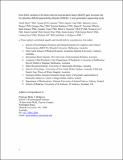Files in this item
Rare DNA variants in the brain derived neurotrophic factor gene increase risk for attention deficit hyperactivity disorder : a next generation sequencing study
Item metadata
| dc.contributor.author | Hawi, Ziarih | |
| dc.contributor.author | Cummins, Tarrant D R | |
| dc.contributor.author | Tong, Janette | |
| dc.contributor.author | Arcos-Burgos, Mauricio | |
| dc.contributor.author | Zhao, Qiongyi | |
| dc.contributor.author | Matthews, Natasha | |
| dc.contributor.author | Newman, Daniel P | |
| dc.contributor.author | Johnson, Beth | |
| dc.contributor.author | Vance, Alasdair | |
| dc.contributor.author | Heussler, Helen S | |
| dc.contributor.author | Levy, Florence | |
| dc.contributor.author | Easteal, Simon | |
| dc.contributor.author | Wray, Naomi | |
| dc.contributor.author | Kenny, Elaine | |
| dc.contributor.author | Morris, Derek | |
| dc.contributor.author | Kent, Lindsey | |
| dc.contributor.author | Gill, Michael | |
| dc.contributor.author | Bellgrove, Mark | |
| dc.date.accessioned | 2017-01-29T00:32:32Z | |
| dc.date.available | 2017-01-29T00:32:32Z | |
| dc.date.issued | 2017-04 | |
| dc.identifier | 242397596 | |
| dc.identifier | 2576ad89-bc71-4641-a184-fdcbb3710427 | |
| dc.identifier | 84979499928 | |
| dc.identifier | 000397099900012 | |
| dc.identifier.citation | Hawi , Z , Cummins , T D R , Tong , J , Arcos-Burgos , M , Zhao , Q , Matthews , N , Newman , D P , Johnson , B , Vance , A , Heussler , H S , Levy , F , Easteal , S , Wray , N , Kenny , E , Morris , D , Kent , L , Gill , M & Bellgrove , M 2017 , ' Rare DNA variants in the brain derived neurotrophic factor gene increase risk for attention deficit hyperactivity disorder : a next generation sequencing study ' , Molecular Psychiatry , vol. 22 , no. 4 , pp. 580-584 . https://doi.org/10.1038/mp.2016.117 | en |
| dc.identifier.issn | 1359-4184 | |
| dc.identifier.other | ORCID: /0000-0002-5315-3399/work/60195341 | |
| dc.identifier.uri | https://hdl.handle.net/10023/10193 | |
| dc.description | This work was supported by a grant from the National Health and Medical Research Council of Australia (NHMRC) (APP1065677). | en |
| dc.description.abstract | Attention deficit hyperactivity disorder (ADHD) is a prevalent and highly heritable disorder of childhood with negative lifetime outcomes. Although candidate gene and genome wide association studies have identified promising common variant signals, these explain only a fraction of the heritability of ADHD. The observation that rare structural variants confer substantial risk to psychiatric disorders suggests that rare variants might explain a portion of the missing heritability for ADHD. Here we performed the first large-scale next generation targeted sequencing study of ADHD in 152 child and adolescent cases and 188 controls across an a priori set of 117 genes. A multi-marker gene level analysis of rare (< 1% frequency) single nucleotide variants (SNVs) revealed that the gene encoding brain derived neurotrophic factor (BDNF) was associated with ADHD at Bonferroni corrected levels. Sanger sequencing confirmed the existence of all novel rare BDNF variants. Our results implicate BDNF as a genetic risk factor for ADHD, potentially by virtue of its critical role in neurodevelopment and synaptic plasticity. | |
| dc.format.extent | 5 | |
| dc.format.extent | 230685 | |
| dc.language.iso | eng | |
| dc.relation.ispartof | Molecular Psychiatry | en |
| dc.subject | QH426 Genetics | en |
| dc.subject | RC0321 Neuroscience. Biological psychiatry. Neuropsychiatry | en |
| dc.subject | DAS | en |
| dc.subject.lcc | QH426 | en |
| dc.subject.lcc | RC0321 | en |
| dc.title | Rare DNA variants in the brain derived neurotrophic factor gene increase risk for attention deficit hyperactivity disorder : a next generation sequencing study | en |
| dc.type | Journal article | en |
| dc.contributor.institution | University of St Andrews. School of Medicine | en |
| dc.contributor.institution | University of St Andrews. Institute of Behavioural and Neural Sciences | en |
| dc.identifier.doi | https://doi.org/10.1038/mp.2016.117 | |
| dc.description.status | Peer reviewed | en |
| dc.date.embargoedUntil | 2017-01-28 |
This item appears in the following Collection(s)
Items in the St Andrews Research Repository are protected by copyright, with all rights reserved, unless otherwise indicated.

